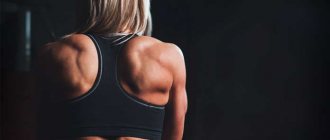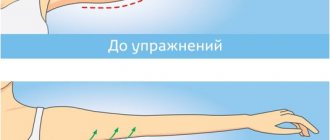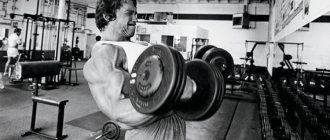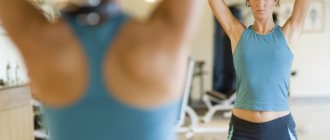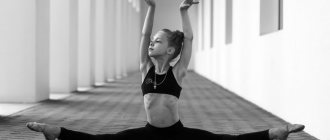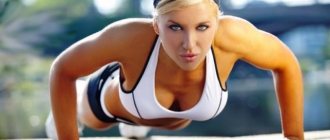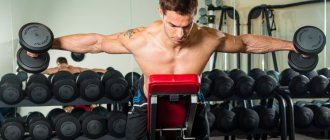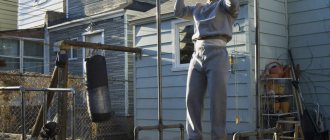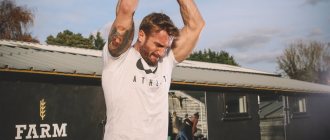Classification of exercises on the horizontal bar for all muscle groups
Before moving directly to the training tasks, it is necessary to distribute them according to the principle of implementation. If one athlete likes to work in dynamics, then for another the best result is achieved by statics. The following table will help you decide on the most effective exercises on the horizontal bar:
| Category | Type of load | Examples of problems |
| Static exercises on the horizontal bar | Certain muscle groups work by holding them in a specific position for a long time | Hanging on the crossbar, “corner”, “horizon” |
| Dynamic power elements | Muscle groups are activated by repeating a specific movement multiple times. | Pull-ups with different grips and different variations in hand placement, hanging leg raises |
| Gymnastic tasks | The work of almost all muscle groups in one element from the field of gymnastics | Exit by force, pirouette |
All of these tasks will be discussed in detail later in the article.
Muscle groups that are involved
Any exercise is performed with hands on the arms, so the parallel bars help develop completely different muscle groups. Exercises will help to form the following muscles:
- dips
are the first thing that should be stressed during exercise; - deltoid muscles - with the gradual use of barbells and dumbbells;
- lower bundles of pectoral muscles;
- abdominal Press.
Depending on the type of training, one or another muscle group can be used as much as possible. For example, when doing push-ups, the muscles of the arms and chest are involved in the work, and if you perform the “corner” exercise, then the abdominal press and gluteal muscles.
In order for sports to bring positive results, exercises on the uneven bars must be performed technically correctly. For each category there is a special program that will allow you to gradually develop your body.
We train our hands
Any element performed on the crossbar involves the hands to one degree or another. But if your goal is to pump up your arms specifically, and even in their different zones, then the ideal solution would be to train your arms on the horizontal bar. In particular, it consists of one-arm pull-ups. To master the task you must:
- Pull yourself up on the crossbar with a reverse grip with both hands.
- Lower one limb and grab the wrist with your other hand.
- Slowly lower.
Do the same with the other hand.
Important: if you wish, you can train your biceps, triceps and shoulders separately.
How to pump up your biceps
To pump up your biceps, just master the following exercise:
- We grab the bar with a reverse grip. We place our hands together and bend our back.
- We pull ourselves up, squeezing our shoulder blades together and moving our shoulders back. In this case, you need to arch your back as far as possible, and touch the horizontal bar with your chest.
- Slowly we descend.
Important! The required result can be achieved only with strict adherence to the execution technique.
Triceps exercises
You can work the triceps on the horizontal bar like this:
- We place one fist in front of the other on the crossbar.
- We lift up, alternately moving our heads to the left and to the right.
- We lower ourselves slowly after each rise.
Important! Between approaches you need to change the position of your hands.
We swing our shoulders on the horizontal bar
Shoulder exercise consists of the following steps:
- We take hold of the crossbar with a direct grip, while our hands are nearby.
- Bend your back and pull yourself up to chest level.
- Slowly we descend.
Possible contraindications
For a number of diseases, gymnastics on the horizontal bar can cause significant harm instead of benefit:
- You cannot perform similar exercises on the horizontal bar and parallel bars if you have scoliosis, even its mild form;
- You should exercise extremely carefully on the horizontal bar if you have osteochondrosis, dismounts are especially harmful (it is better to substitute a chair);
- This apparatus is strictly contraindicated for any, even small, herniated intervertebral discs (you can’t even hang on the horizontal bar).
There are other, more specific diseases, including joint diseases, for which exercise on the horizontal bar is prohibited. In each specific case, it is advisable to consult a therapist or physical therapy specialist.
It is important to remember that the wrong technique can make even a simple pull-up on a bar dangerous. A typical mistake for beginners is throwing their head back and lifting their chin up. Instinctively, many people take a breath while squeezing their shoulders together. This is fraught with serious injuries to the cervical vertebrae. Proper breathing (as described above) helps the latissimus dorsi muscles, which “push” the body upward, to perform the task. In general, for serious training and uniform training of all muscle groups, it is worth drawing up a training plan on the horizontal bar and uneven bars.
In addition, you cannot, trying to complete a repetition at all costs, squirm your whole body when doing pull-ups on the horizontal bar. You need to lift yourself by lowering your elbows strictly vertically. The main thing is no haste, correct technique and gradually increasing the number of repetitions using new grips.
Exercises on the horizontal bar and parallel bars are contraindicated for scoliosis, osteochondrosis and herniated intervertebral discs
Incorrect technique for performing exercises on the crossbar can lead to serious injuries to the cervical vertebrae.
The main thing in classes is the absence of haste and a gradual increase in the number of repetitions using new grips
All attention to the spine
Using the crossbar, you can work on almost every part of the spinal column. And if you consider that during the training the spine relaxes and is in the correct physiological shape, the risk of injury when working on the crossbar is minimal.
The exercise machine can not only make your back sculpted, but also correct your posture, and also relieve lower back pain.
Top 7 exercises for a strong back
To work out the back muscles, the following elements are recommended:
- Traditional body lifts. The main load goes to the latissimus muscles, so it is important to feel their contraction. You need to perform the element smoothly, without jerking or throwing yourself down. Hands should be in constant tension.
- Neutral grip pull-ups. The latissimus muscles also work here. The main thing is not to forget to change hands and bring forward either the left or the right limb.
- Raises under the chest with a back bend A complex element that works the center of the back. When performing it, you need to use a reverse grip and bend back so that the crossbars touch the costal arches of the pectoral muscles.
- Australian version An excellent task on the trapeze on the horizontal bar. This requires a wide grip and a low bar. Starting position – lying down under the crossbar.
- Archer Great for engaging the center of the back and lats. During execution, one arm should be moved slightly to the side. We change hands during the training.
- Wide grip body raises. The main task here is to bring the shoulder blades together as much as possible and move the elbows to the side. The load on the back increases with increasing grip width.
- Parallel grip pull-ups. The latissimus and teres dorsi muscles are used.
Important ! For each element you need to devote 3-4 approaches and 10-15 repetitions in each of them.
Healthy lower back
To strengthen the lower back on the horizontal bar, you can resort to pull-ups with a medium and wide grip, as well as leg raises on the bar with scrolling at the top of the pelvis.
Movements should under no circumstances be sudden. All actions must occur through muscle contraction.
The best exercises for posture on the horizontal bar
To correct your posture, simply hang from a crossbar for a few minutes a day. This will relax the spine and allow the vertebrae to take their rightful places. This action will also help with scoliosis. Main:
- no need to swing;
- ensure that your back is always straight;
- the shoulders were relaxed.
Any back training should be accompanied by a preliminary warm-up. Especially if there are any problems.
How to Incorporate Dips into Your Workout
- If you work out at the gym, add dips to your routine on triceps and chest day. Perform 3–5 sets of 6–12 reps.
- Keep in mind that the last few times of the approach should be difficult for you. If you need to use a belt with a weight plate to do this, do push-ups with the belt.
- If you work out at home or outside, do dips 2-3 times a week, resting at least 48 hours between workouts. Perform 3-5 sets, repetitions - as many as you can.
- If you can do more than 15 reps per set, consider purchasing a weighted vest.
Pumping up the pectoral muscles: the best six exercises
The following elements are suitable for the pectoral muscles:
- Close grip pull-ups with hands pressed together
- Reverse Grip Raises
- Combining close and reverse grip
- Press from the crossbar To perform it, you need to climb onto the crossbar, lean forward slightly and begin to lower yourself down until your chest touches the horizontal bar.
- Wide grip pull-ups
- Power output consists of the practitioner pushing himself with both hands over the bar to the level of the lower back.
Do you want to learn more about how to pump up your back and chest on the bar? Watch the following video:
Complex loads for a projectile
Sets of parallel bars exercises should primarily differ depending on their target audience. This fact is due to physiological differences between men and women who decided to pump up the body with the help of the projectile in question.
For men
For training on the uneven bars, fitness trainers recommend that men pay attention to the following training program, which is rightfully considered one of the most effective in its segment specifically for the stronger half of humanity:
- Cardio training on a treadmill – 20 minutes.
- Horizontal pull-ups – 3 sets of 15 reps. Starting position (IP): take a horizontal position, positioning the body in weight; it is necessary to hold on to the bars with your hands and feet at the level of your hands; limbs should be straight; the backs of the palms are directed towards each other. As you exhale, bend your arms at the elbow joint, bringing your body as close to the bars as possible. After fixing the position for 3 seconds, slowly return to the original position.
- Upside down crunches – 3 sets of 20 reps. IP: secure your legs on the uneven bars, holding one crossbar in the area of the bent knee joint; the body hangs freely upside down; press your hands to your chest. Simultaneously with exhalation, raise the upper part of the body towards the legs, making sure that only the abs are working. Without pausing in the upper position, in parallel with inhalation, take IP.
- Classic push-ups over uneven bars – 3 sets of 20 reps. IP: take the position as before starting traditional push-ups, but placing your legs and arms on the parallel bars. Once above the projectile, it is important to make sure that the position is stable and that there are no deflections in the body and limbs. Exhaling through your mouth, smoothly bend your arms at the elbow joint, getting as close as possible to the sports equipment. Without stopping at the bottom point, return to the starting position simultaneously with inhalation.
- Running in place with high hip raises – 10 minutes.
- Stretching exercises or breathing exercises.
For girls
For girls, the most effective training on uneven bars will be the following version of a set of exercises:
- Deep squat jumps – 15 minutes.
- Classic wide grip pull-ups – 3 sets of 15 reps. Starting position (IP): grab one of the crossbars with your hands, placing them as far apart as possible; the backs of the hands are directed away from the athlete; cross your legs and tuck them together; straighten your shoulders. In parallel with exhalation, pull the body up, bending your arms at the elbow joint; Touching the bar with your chin, slowly return to the IP position.
- Leg raises to pump up the lower abs – 3 sets of 20 reps. IP: grab one of the crossbars with your hands, turning your face away from the projectile; lift your legs off the supporting surface without bending them; straighten your shoulders. Exhaling through your mouth, raise your straight legs as high as possible, using exclusively your lower abs. Without lingering in this position, slowly lower your limbs, taking IP.
- Classic close-grip pull-ups – 3 sets of 20 reps. The IP and exercise technique are similar to pull-ups on parallel bars using a wide grip. The only difference is that in this case, the hands need to be placed on the bar slightly narrower than shoulder width.
- Cardio training on a treadmill or stepper/running in place – 20 minutes.
- Cool down with elements of stretching worked muscles and breathing exercises.
Important! Regardless of the complexity and intensity of the workout, the key to properly organizing the session is breathing control. Traditionally, when exhaling through the mouth, the athlete should perform an effort, and when inhaling through the nose, return to the original position.
Be sure to check out:
Swinging on the uneven bars and horizontal bar: an effective training program Pull-up program on the bar: technical nuances and tips Training on the horizontal bar: exercises and methods Pull-ups on the horizontal bar for the health and beauty of the body
Strong press
The abs are also perfectly worked with the help of a crossbar. To do this, you can add the following tasks to the training program:
- Frog. Works the lower abs perfectly. To perform this, you need to pull your bent legs towards your stomach while hanging. Hold this for three seconds and raise your legs to your chest. To complicate the option, you can further move your knees towards your chin.
- Hanging leg raises. Also suitable for lower press work.
- U-turns. Works the oblique abdominal muscles. To perform this, it is necessary to turn the body in different directions from the “frog” position.
- Pirouette. An element for men who are already actively practicing on the horizontal bar. The essence of the pirouette is to lift the body until the chin reaches the bar. Next, you need to throw your legs up and perform a coup with outstretched arms.
- Upside down. Suitable for working out the upper abs. To do this, you need to hold the crossbar with your knees and lower your arms down. Next, you need to lift the body, lingering at the bend point for several seconds. You can make the task more difficult by making turns in different directions.
- Corner. The same hanging leg raises, but with a maximum time delay. Straight legs should form a right angle with the body. To complicate the task, you can, while holding your toes, describe figures in the air, paying maximum attention to the oblique abdominal muscles.
You can get even more abdominal exercises from the following video:
Exercises
Each level of training requires its own program. Beginners should not do what is intended for professionals. The load should be taken on gradually.
The level program looks like this:
- Program for beginners. Visits to the bars are made 3-5 times a week. The exercises here are:
- jumping onto the uneven bars and then going out onto straight arms, while it is important that the body does not sway;
a position is assumed on outstretched arms, after which the knees begin to raise to the shoulders;
- negative push-ups - the body is lowered down for 6-8 counts, after which they jump off the uneven bars rather than returning to their original position;
- push-ups on the crossbar - the upper and lower limbs are placed on the handrails, after which the bending goes into the void that is located between them.
- Program for experienced people. You can start such classes after a month of training for beginners. Here push-ups will be performed at least 20 times in one approach. But a few more exercises are added to them:
- with straight arms, the body is fixed on the uneven bars, after which the straight legs begin to rise to 90 degrees;
the initial position will require straight arms, and then the legs are raised alternately;
- the legs are bent at the knees, so that the feet are higher than the bars, after which the torso and bent legs begin to spread in different directions, while the arms should not bend at the elbows;
- similarly, the exercise can be performed with straight legs;
- push-ups are performed with a corner;
- diagonal push-ups - place your feet on the crossbar and your hands on the floor, performing the lowest possible press (but this exercise is prohibited for people who have problems with the cardiovascular system or have poor eyesight);
- walking on hands on uneven bars, but it is necessary to control so that the body does not sway;
- jumping on the bars, assistance with legs is allowed.
- Expert Program. For those who have been familiar with parallel bars for a long time, you can try the following complexes:
- from straight arms they move to their forearms, after which they return to the original stance and do push-ups, then the transition and push-ups are repeated;
- do push-ups on the uneven bars, but in a low position it is necessary to switch to the forearms;
- on straight arms, swings are performed with legs, which are then turned in different directions;
- hang on the uneven bars from below and try to stand on the crossbar with bent legs;
- turns around yourself on straight arms.
The exercises alternate with each other.
There is also another effective exercise for experienced practitioners. But it will require bars of different heights. We approach the projectile from the inside, grab the bottom bar with one hand, and the top bar with the other. And the pull-ups to the top bar begin.
And this is not the whole set of exercises. The main thing is to move from one stage to another gradually, slowly increasing intensity and complexity.
What else can you do with a horizontal bar?
The crossbar is truly a unique exercise machine. With its help, you can make not only the usual elements, but also some unimaginable pirouettes, which are not accessible to everyone. Also, sports equipment will be useful for those who are dissatisfied with their height: with its help you can grow a few centimeters.
Horizon on the horizontal bar
The horizon is one of the workout elements that can be used to improve:
- delta;
- round muscles of the back;
- extensors of the spinal column;
- press;
- pectoral muscles;
- stabilizers;
- triceps.
The exercise belongs to the static elements of strength gymnastics. It requires high physical fitness and can be represented by such types as: side, on one arm, airplane.
To perform the horizontal, you need to have developed abs, legs, pectoral muscles, triceps and shoulders. Only the presence of this set will allow you to do the exercise correctly and efficiently.
Due to the complexity of the element, it may not be possible to master it immediately. To begin with, you should learn how to do high pull-ups, and then pull yourself up to the waist. When you touch the crossbar with your belt, your body will have to take an almost horizontal position, which is an excellent foundation for completing the main task.
You can also master the exercise using the embryo method, in which while hanging you need to bend your knees to your chest and raise your butt. Gradually straightening one or the other leg will lead to the fact that one day you will be able to straighten both legs, and even hold them in this position.
Rivet on the crossbar
Another interesting element that hides a special execution technique behind the apparent simplicity of execution. The exercise is called a rivet and consists of swinging, swinging your legs and shoulders with the goal of fixing yourself over the bar with straight arms.
The element strengthens the forearms, shoulders and hands. The legs, back and abs also work.
To perform riveting you need:
- Start swinging while hanging on the crossbar.
- When straight legs reach the maximum point, raise them to the horizontal bar.
- After your legs are thrown forward, you need to raise your pelvis and shoulders with straight arms.
Important! When moving forward, you need to move your legs forward as much as possible, and when moving back, keep your arms straight and raised at the shoulders.
You can learn more about the riveting technique from the video:
Training to increase height
With the help of tasks on the crossbar, you can significantly increase your height, without leaving your home. To do this, you just need to hang on the crossbar every day. The meaning of this is that the relaxed state alternates with stretching. As a result, the body stretches under its own weight. When hanging, you can use both a forward and reverse grip.
It will also help you grow:
- swing your legs while hanging back and forth, in different directions;
- hanging leg raises with knees back;
- hanging backbends;
- turns while hanging with a straight body in different directions;
- imitation of a hanging pendulum;
- circular movements of the legs while hanging straight and in different directions.
Exercises using a chair are also interesting. So it is possible
- pull yourself up, leaning on one or the other leg on a chair;
- while hanging, bring your bent legs over a chair placed behind you;
- while hanging, bring your straight legs over a chair placed in front.
So, by completing these simple tasks, you can not only pump up almost all muscle groups, but also become a little taller.
Exercises on parallel bars
On the uneven bars (height 175 cm from the surface of the mats) exercises characteristic of many types of gymnastic all-around are performed. These include static, strength, dynamic and swing exercises. They are performed in stops and hangs, across and longitudinally in relation to the projectile, on one and two poles, with alternating and simultaneous interceptions of the hands, in the middle and at the ends of the poles, facing outward and inward. To successfully master exercises on this apparatus, you need well-developed strength in the muscles of the arms, shoulder girdle, abdomen and back, high mobility in the shoulder and hip joints, orientation in space and a sense of balance, emotional stability, determination and courage, correct posture in hangs and supports. These abilities develop before and during the process of mastering complex exercises.
To perform exercises on the uneven bars, various grips on the apparatus are used: in the hanging position - an outside grip, when the back surfaces of the hands, together with the thumb, are in a position outward from the poles; from the inside - when the back surfaces of the hands and thumbs are facing each other, inside the bars; in support - a normal grip, a reverse grip (the back surface of one of the hands is facing inside the bars).
The simplest static and dynamic exercises are included in the school physical education curriculum from parallel bars exercises.
Static exercises include mixed and simple hangs and supports.
Mixed hangs
are performed mainly on one pole longitudinally, like on a crossbar. It is possible to hang crosswise on two poles with support from the legs using a curtain from inside and outside the poles.
Simple hangs
include hanging, hanging on bent arms, hanging at an angle, hanging bent over, hanging over, hanging from behind, horizontal hanging from front and back.
Mixed stops:
sitting legs apart, sitting on the left (right) thigh On one pole inside and outside, lying down and lying down behind Legs on poles, standing on one and two knees, lying down
g 'imnaetics 257
longitudinally on one and two legs, support lying and support lying behind on the forearms of the legs on the poles, support standing bent.
To simple stops
include: support, support on the forearms, support on the hands, support at an angle, horizontal support on the elbow, bent support, stand on the forearms, handstand, horizontal support on the hands.
Emphasis
- the torso is raised and together with the legs forms a straight line, the chest is slightly turned out, the head is straight. The arms, straightened to the limit, rest on the poles with the entire palmar surface, the elbows are slightly turned inward. When learning the support in developing the strength of the muscles that hold the body in support, exercises in support are used while lying on the floor, on a gymnastic bench, a wall with feet resting on the slats, hand-walking on parallel bars with falling and lifting the body in the shoulder joints, jumping in support, long-term hold high support, turns in support on one pole and back, etc. Insurance and assistance are provided while standing on the side of the shoulder and forearm.
Forearm support
- the body is straightened, the angle between the shoulder and forearm is straight, the head is straight, the elbows are slightly shifted inward, the hands clasp the poles from the outside and from below.
Hand rest
performed with a straight body without sagging in the shoulder joints, the arms are slightly bent at the elbow joints, the hands clasp the poles, leaning on them mainly from the outside. The shoulders in relation to the poles are located at an angle of approximately 45°. Performing this emphasis requires fairly well-developed strength in the pectoral and latissimus dorsi muscles.
At an angle
arms straightened, back straight, head straight, legs parallel to the poles. Its varieties are: emphasis with the leg angle apart, emphasis at a high angle, horizontal emphasis in front bent. They are included in combinations of qualified gymnasts and require well-developed strength of the iliopsoas muscles, abdominal muscles, anterior and inner thighs, and high mobility in the hip joints.
Horizontal support on the elbow
performed with a slightly bent body, resting on the elbow of a bent arm, brought under the iliac crest, the other arm is straightened, the head is raised (Fig. 192). The exercise is first mastered on stands with
with help, and then on low and high bars. It can be performed on one hand without relying on the other.
Horizontal emphasis on straight arms
performed due to great tension in the muscles of the arms, shoulder girdle and back surface of the body. It is used for intensive development of these muscle groups, and qualified gymnasts include it in their combinations. Insurance and assistance when performing these supports are carried out while standing on the side under the shoulder and hip.
Bent over arms
- position of the body in support on the hands with the legs raised towards oneself at an angle of 45° (Fig. 193). Balance is maintained due to the strength of the muscles of the hands, ensuring the alignment of the projection of the body's central mass with the middle of the support area. The study of this exercise is carried out on the floor, on low, and then on high bars with a swing of one and a push of the other, a push of two legs, from swinging, with help and independently. Insurance and assistance are provided while standing on the side under the back and pelvis.
Shoulderstand
can be performed from a sitting position with the legs apart, from an angle and a swing.
To perform a saddle stand with your legs apart, you must first grab your hands closer to your hips, move your shoulders forward, force your hips off the poles, then, when your torso takes a vertical position, spread your elbows to the sides, lower your shoulders on the poles in front of your hands at a distance convenient for maintaining balance, straighten at the hip joints, connect your legs and move into a shoulder stand with a straight or slightly arched body and fix it.
A shoulder stand from an angle position is performed in basically the same way as from a squat with legs apart, only in this case it requires significantly more tension in the muscles of the arms, shoulder girdle and back. The exercise begins with lifting the pelvis and back up and moving the shoulders forward relative to the hands. As the back approaches a vertical position, the arms are bent, the elbows are spread, and the shoulders are placed on the poles. The stand is completed in the same way as a sit-up with your legs apart.
The swing shoulder stand is performed on the backswing. As the legs approach the upper vertical, the arms are smoothly bent, the elbows are spread to the sides, the shoulders are placed on the poles and the shoulder stand is fixed (Fig. 194).
Learning these shoulder stand variations begins on stands or low bars. To do this, from a standing position, bending over on a horse or goat installed under the poles, place your shoulders on the poles and, pushing with your toes, come out into a shoulder stand. The shoulder stand is studied in a swing after mastering it from a sitting position. Legs apart and from an angle, first on low and then on high bars. Insurance and assistance are provided while standing on the side under the hip and shoulder.
Handstand
performed with a swing and force. Its varieties are a longitudinal stand, a stand on one arm, a stand on one pole (see Fig. 106).
The swing handstand is performed with an almost straight body. When performing a backswing, after the legs pass the lower vertical, the shoulders smoothly and synchronously with the movement of the legs move forward in such a way as to facilitate the movement of the body to the upper vertical. As you approach it, the shoulders smoothly move back and stop as the body enters a handstand.
Power handstands are performed in different ways: with bent legs, bent over, bent over, straight and bent arms, with spread and closed legs, from various starting positions. In this case, the main load falls on the muscles of the arms, shoulder girdle and back. Movement in all joints ends simultaneously with the fixation of the stance. Before starting to study it, they develop the strength of those muscle groups that take part in its implementation, master the correct position of the body in a handstand on the floor and on stands with the help and independently, then proceed to perform it at the ends of low bars facing outwards, in the middle and finish learning on high bars. Students are first trained in self-insurance methods. Insurance and assistance are provided while standing on a raised platform with one hand over the shoulder or under the chest, the other under the back (Fig. 195).
Simple dynamic exercises include somersaults, variations of swings, lifts and dismounts.
Forward somersault
performed from a sitting position with legs apart, from a standing position bent over, etc. Somersault training begins from a sitting position with legs apart. To do this, you need to grab your hands forward close to your hips, then, bending and raising your pelvis, spread your elbows wide to the sides, put your shoulders closer to your hands, tilt your head forward.
ed; Without letting go of your hands, start somersaulting; Having balanced the body in the support position, bending over and joining your legs, grab your arms forward and then with an active movement of your legs forward, complete a somersault into a sitting position with your legs apart (Fig. 196). The study begins with mastering the forward somersault while bending on the floor. To do this, you need to stand in a position with your legs apart, lean forward, rest your hands on the floor and, bending them, lower yourself onto your shoulder blades; tilt your head forward and roll forward to a supine position; join your legs and, leaning your hands on the floor, roll forward into a sitting position, legs apart, hands on the floor behind you. Having learned how to correctly perform all the movements on the floor, you can begin to perform exercises on the uneven bars, first with help, and then on your own. For training, you can use a mat placed on the bars. Insurance and assistance are provided while standing on the side, placing one leg under the bars and supporting the trainee with two hands under the back and pelvis.
Swing exercises include: swinging in support, in support on the forearms and on the arms, in the hang; turns and circles; dismounts on the swing forward and backward; Kip-ups from hanging and support
on hands; swing lifts forward and backward; forward and backward somersaults, shoulder and handstands performed in a swing.
Swinging at point-blank range
represents a pendulum-like movement of the body. The forward swing is performed with slight flexion of the body at the hip joints due to tension in the muscles of the arms and the front surface of the body. As you swing forward, your shoulders move back slightly. In the lower vertical position, the torso and legs are straightened. The backswing is accomplished through the work of the muscles on the back surface of the body. After the body passes the vertical, the shoulders move forward, the back slightly advances the movement of the legs, and at the end of the swing the legs overtake the body. Swinging is studied through various exercises in mixed and simple stops. Insurance and assistance are carried out standing on the side of the shoulder and forearm.
Swinging on hands
The technique of execution is similar to swinging at point-blank range. When performing it, you should not sink in the shoulder joints, especially when swinging with a large amplitude. The study begins by holding the pose while swinging forward and backward with the help of; then swing with a gradual increase in amplitude until it stops, bending on the forward swing to a position similar to a stand on the shoulder blades, and on the backward swing to a horizontal position. Insurance and assistance are provided while standing on the side under the legs and torso from under the poles.
Swinging while hanging
performed at the ends or inside the bars from a jump, from a run, from an angle hang or after falling back from an emphasis. When performing a swing from a jump, the gymnast first assumes a standing hanging position with arms and legs fully extended, feet under the grip points. The swing is created by pushing the legs up along the longitudinal axis of the body with simultaneous pressure with the hands on the poles, in such a way as to create forward movement of the required amplitude. When passing the vertical, the torso and legs straighten, after which, due to the work of the pectoral muscles, latissimus dorsi, abdominal muscles and iliopsoas muscles, a bent hanging position is assumed. When passing through the vertical while hanging, the pelvis does not drop, the middle of the thigh is at the level of the hand grip. Next, a forward-upward swing is performed while hanging, bent over, with the body extended at the hip joints, after which the legs immediately approach the body. With the end of the up-and-forward swing and the beginning of the reverse movement, after passing the vertical, a short energetic extension is performed while simultaneously pressing the hands on the poles. At the end point of the swing, a final movement is made, which allows you to perform a number of elements: a kip-up, a back lift, a forward somersault, a swing of one or two over the poles, circles or just a high back swing, etc. Swinging is studied in a hanging position, bent.
When shaking, assistance is used to strengthen the swing. Insurance and assistance are provided while standing on the side under the back and pelvis.
Circle right with a turn to the left-circle alternately intercepting hands
performed at the end of a small forward swing. Spreading your legs and moving to the left, transfer the weight of the body to your left hand, turning to the left with your right leg swinging over the left pole, resting longitudinally and quickly placing your right hand on the left pole, transferring the weight of the body to it. Continuing to move your legs to the left, push off with your left hand, swing your right leg to the left with a turn to the left and quickly place your left hand on the left pole. After completing the turn, a back swing is made (Fig. 197). Correct execution of the exercise largely depends on a good swing of the left leg forward. This exercise can be performed in the other direction. It is studied in the following sequence: in support across and longitudinally, alternating push-offs with the hands; from the stop, swing forward, turn to the left with the right hand placed on the left pole, point-blank longitudinally; from the stop longitudinally, moving the legs to the left, turn to the left with the left hand placed at the stop across; connection at the pace of the two previous exercises; from the stop longitudinally with your right legs apart, swing to the left, turn to the left with the right leg swinging across to the stop. All these exercises are first performed on low and then on high bars.
Of the dismounts on the forward swing, the simplest are: an angle to the left (right) without turning and with a turn to the right (left) and in a circle, sideways.
Angle dismount
performed from swinging at point-blank range. After the backswing, as the body approaches the vertical, the torso advances the movement of the legs. This achieves the extinction of the angular velocity of movement of the torso and legs towards the completion of the forward swing. Then the legs again overtake the body and form an angle with it at the moment of dismount. With a push of the hand on the opposite side of the dismount, the body's central mass is transferred to the hand beyond the area of support of the supporting hand. The pushing hand is transferred to the pole through which the dismount is performed and holds the body in a stable position at the moment of landing, the supporting hand is freed from support and provides
performs a gymnastic jumping pose (Fig. 198). When studying, first a dismount from a seat is performed on the hip by swinging over both poles; then dismount forward in a swing with help on low, high bars and independently. Insurance and assistance are provided standing from the side and slightly behind the right (left) arm and under the back.
Dismount forward swing with a circle turn
performed from swinging at point-blank range. During the forward swing, the torso and legs, bending at the hip joints, are actively directed upward and towards the dismount. Towards the final point of the swing, the legs should accumulate the greatest possible angular momentum and, due to an energetic step with the hand on the same side of the dismount, and support on the legs, using the angular momentum acquired by them, a turn is made in a circle with simultaneous extension of the body in the hip joints into a bent position . The turn begins with the feet and ends with the shoulders. The hand free from support grabs the pole through which the dismount is performed and holds the gymnast in a stable position at the moment of landing, the other hand forms the landing pose (Fig. 199). At
the study needs to: perform a dismount with a forward swing with a slightly early transfer of the body's central motion to the supporting hand and shift it towards the pushing hand; from the seat on the right pole across (legs outside), grab your right hand forward with a reverse grip and, pushing off with your hips and left hand, perform a dismount with a turn of 90° (facing the apparatus), and then 180°. Belaying must be done while standing to the side, slightly behind the performer. Provide assistance after releasing the right hand by briefly twisting the gymnast under the right side to turn, then pick him up with both hands at waist level and help him land correctly.
Side dismount
performed from swinging at point-blank range. On the forward swing, having passed the vertical, you need to make an energetic swing with your legs up, slightly bending at the hip joints, and when your legs are at head level, start turning them towards the dismount; straighten up and push off with your right hand, while continuing to rotate your pelvis and shoulders, shift towards the dismount. Actively leaning on your left hand, finish the turn in a sideways position, with your right hand to the side. After passing your legs over the pole, lean back with your left hand and land with your back to the bars (Fig. 200). In a similar way, this dismount is performed on the right side. Sequence of study: master the transition from the position lying behind on the floor to the position lying sideways; perform a side dismount from a seat on the hip by swinging over two poles; perform a side dismount on low bars from a stop, resting your left foot on the pole, and swing your right; at the ends of the poles facing out through the rope. Insurance and assistance are provided while standing on the side with one hand under the shoulder, the other under the back (if the legs remain above the poles).
Backswing dismounts also vary greatly in difficulty. The simplest of them are a back swing dismount, bending over, with a 180° turn, legs apart at the ends of the poles.
Backward swing dismount
performed to the right and left from swinging at point-blank range. Having performed a sufficiently high backswing
(the minimum height is the level of the shoulder axis, the maximum is not limited), the gymnast shifts the body to the right side, quickly intercepts the left hand on the right pole in front of the right hand and immediately moves the right hand to the side, leaning on the pole only with the left hand, bending moderately, lands , holding the pole with your left hand. It is performed first on the ends of the low bars using a rope or a gymnastic stick, then on the low and high bars with help and independently. Insurance and assistance are provided by standing on the side of the poles in front of the student, preventing the person from hitting the poles with their feet.
Jump backwards to the right with a right-circle turn
performed from swinging at point-blank range. At the end point of the backswing, you need to shift your body to the right, while simultaneously moving your left hand to the right pole in front of your right hand. Passing over the right pole, push off with your right hand and turn your right shoulder back in a circle. Continuing to shift your body to the right, grab the pole with your right hand and land (Fig. 201). The study begins with simulating a dismount while standing with your left side against the gymnastics wall, grabbing the bar with your left hand at the level of the pelvis. At the end of the backswing, a light jump is made with the right hand on the left, turning the body to the right in a circle and grabbing the rail of the wall with the right hand, the left hand is transferred to the boarding position; running through the heather at the ends of the poles facing inward; dismounting on low and then high bars with help, and then independently. When learning back swing dismounts, trainees' attention is drawn to the correct alternation of support phases: double support on two poles, double support on the right pole (as short as possible in time), single support on the right pole before the turn, single support on the right pole after the turn. Insurance and assistance are provided by standing on the side and supporting the practitioner under the back and chest.
Dismount with legs apart at the ends of the poles
performed by swinging facing outwards. At the extreme point of the backswing (slightly above the horizontal), bend and move your shoulders forward, then slightly
bend at the hip joints, simultaneously with a push with your arms, spread your legs apart, bend and land during the flight phase (Fig. 202). Sequence of study: from the position lying on the floor, transition to the position standing with legs apart, moving forward behind
line of support with your hands (do not bend your legs); from the emphasis lying on the poles with a push of the legs and from swinging on the low bars, the dismount of the legs apart with the help; on low bars from swinging, dismount forward from the ends of the poles without spreading the legs, dismount with a jump first over one, then over the other pole, over both poles with the help and independently on low, and then on high bars. Insurance and assistance are provided standing to the side and slightly in front.
Kip-up from a hanging bent position
performed in the middle and at the ends of the poles. The bended hang can be taken from a running start, from an angle hang, from a jump or after falling back from an emphasis position. The technique of swinging in a bent position is discussed above. With the end of the up-and-forward swing movement, flexion of the torso and legs at the hip joints follows, and at the end of the back swing, vigorous extension with simultaneous active pressing of the hands on the poles in the backward direction. As you reach the point-blank range, straighten up, moving your pelvis and legs forward and upward (Fig. 203). When learning it is necessary: to master swinging in a bent position; learn to perform a kip-up lift using the ends of the poles facing inward from a running start, from a hanging angle and from a jump; After mastering the decline from the emphasis, connect it with the rise with a kip.
Kip-up from a bent-over position on your arms
performed from a handstand position on low parallel bars and from a swinging position on the hands. With a forward swing, raise your straight body and legs above the poles, fold gently, bringing your legs closer to your chest (do not lower your pelvis below
poles), and without stopping, straighten up, pointing your legs and pelvis up and forward. Extension is performed with a quick and short movement of the legs, followed by vigorous tension of the abdominal muscles and iliopsoas muscles, so that the amount of movement acquired by the legs is transferred to the torso and shoulders. At the same time, push off with your shoulders from the poles, use their reactive force and, pressing on the poles with your hands, raise your shoulders up and forward, go to point-blank range; complete the lift with a high back swing (Fig. 204). This exercise is studied in the following sequence: from a seat on a gymnastic mat, roll onto your back, raise your legs into a stand on your shoulder blades and immediately fold gently, lowering your pelvis to the level of the mats, with a short energetic movement of your legs up and forward and pushing off the mat with your hands, roll into a sitting position, legs apart; perform a kip-up on the uneven bars while sitting with your legs apart, a kip-up with help and then on your own. Insurance and assistance are provided while standing on the side with one hand under the back, the other under the pelvis, and when going point-blank under the chest from under the poles. A push under the back helps to push off from the poles in a timely manner, and support under the thigh prevents the pelvis from lowering below the level of the poles and bending the arms in support.
Forward swing lift
performed by swinging in support on your hands. At the end point of the backward swing, the body's central mass moves as far as possible from the support, which creates the greatest moment of inertia. On the forward swing, when the legs approach the vertical, you need to slightly sag in the shoulder joints and further remove the center of gravity of the body from the support. This will create a large angular momentum and cause reactive motion of the poles. In this case, the chest and stomach are ahead of the legs. At the moment of passing the vertical, a whipping movement is made with the legs up and forward, bending at the hip joints and vigorously pushing off the poles with the hands, using their reactive force, to come to a point-blank range (Fig. 205). When learning, it is necessary to master timely and energetic repulsion from the poles and whipping movements with the legs. To do this, you need to lie on your hands in front with your legs apart after a slight lowering of the body in the shoulder joints by actively pushing away from the poles and pressing
with your hands on them, sit your legs apart, bend your arms on the back swing, and straighten your arms on the forward swing with a whipping movement of the legs upward. Then proceed to perform a forward swing lift with assistance. She finds herself from under the poles with one hand under her back and the other under her legs. The belay turns out to be standing on the side under the pelvis and shoulders. In case of falling forward when going to point-blank range, support under the chest from under the poles.
Backward swing
performed by swinging in support on your hands. On the forward swing, you must, bending at the hip joints, take an emphasis bent on your arms and, without stopping in this position, bend forward slightly above the poles, pull your shoulders to your hands and begin the backswing. Before passing the vertical, the torso bends slightly and moves ahead of the legs. Behind the vertical, the swing is intensified by an energetic whipping movement of the legs (they are ahead of the movement of the torso) and is followed by pushing off the poles with the hands while simultaneously pushing the shoulders forward and upward until reaching point-blank range. Full straightening of the arms should coincide in time with stopping the backward movement of the feet (Fig. 206).
When learning this element, you must first learn how to perform: lifting with a backswing from swinging in support on the forearms; swinging in support with bending the arms on the forward swing and extension on the back swing due to the whipping movement of the legs back and forth; shoulder stand and
sequential flexion and extension in the hip joints; from swinging in support on the hands, pulling (throwing) the shoulders to the hands; the same, but in combination with a back swing. Then you can move on to performing a backswing lift with help and on your own. Help is provided with hands from under the poles under the legs and chest; the same, but with fixation of the backward swing in the final position (above the horizontal). The belay turns out to be standing on the side with one hand under the chest, the other under the thigh.
Somersault bending forward
performed by continuing the backswing. As the body approaches the upper vertical, the arms are spread to the sides, pressing on the poles, and at the moment it passes, the head tilts to the chest, the back is rounded. Then, ahead of the body movement, the hands grab the poles and the backswing continues.
Back somersault bending over
performed by continuing the forward swing. As the body approaches the upper vertical, it is necessary to spread your arms to the sides, pressing on the poles, bend over, grab them and continue the forward swing (Fig. 207). When learning, these somersaults are performed first from a shoulder stand position, then from swinging with help and independently. Insurance and assistance are provided under the back and chest from under the poles.

